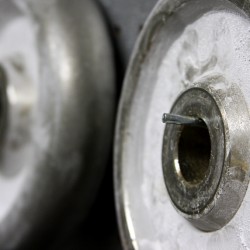The Studios
After years of working in other studios, Kerrick meticulously designed and built all of his own equipment specifically for his work both in size and demand. Over the course of seven years, he planned and saved. He diligently collects the right pieces from a metal scrap yard near his studio in Chattanooga. He build his lathe first, then a house with a studio attached, and finally in 2010, Kerrick completed the hot shop equipment and opened his studio.
Color Selection
Because Kerrick is color blind, he is not limited to a particular color palette but finds inspiration in vibrant color combinations often found in nature. He prefers vivid hues that are high in contrast so he can see them. Subtle color combinations are lost on him. To Kerrick, the most important aspect of his work is not the color but the lines created, the form and the optics.
Now that the color is in place, he blows the glass and begins to work it into the final shape. Kerrick typically works alone in his studio and creates a blown piece in about two hours. Then the work is set aside in the annealer for about two days to cool.Kerrick employs the Swedish overlay process and wraps the outside or secondary color over the first color. Then he add a few more gathers of clear glass to encase the colors and create a extra depth. These many thick layers of glass create a rich canvas for future carving.
Cold Working
Each piece is an evolution of the one before it. Pattern is determined by color and shape and inspiration. If the work is over the top in color, then the cold working is more likely to be subtle. Patterns are often carved into areas that will reveal the most optics and have the highest visual impact.
If the work is busy, he uses the matte finish of stone engraving to slow down the viewer’s eye. Most of the time the design just falls into place. As Kerrick starts to carve, the pattern reveals itself. Each piece teaches him and he uses that in the next work. Certain pieces demand structure and other are more free form.
The carving tools Kerrick uses have been in use for hundreds of years. He uses industrial diamond wheels to remove and refine carving. Then uses a pumice wheel for pre-polish and a cerium wheel for the final polish. Each divit or groove requires a 4-5 step process to remove the glass and then bring back to a full polish.
“I love it because with each piece I learn. I’m still learning glass and what it can do,” states Kerrick after sixteen years in glass.
Photography
Kerrick considers photography part of the process of his craft. As he cold works, he gains unique understanding of what makes each piece remarkable. He is able to capture this in his photography in a way that only the creator could. It would be impossible to relay this information to another photographer. Kerrick’s photography is the key to understanding the beauty and artistry in each piece.


